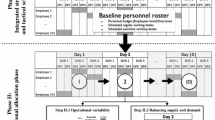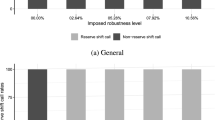Abstract
Organisations usually construct personnel rosters under the assumption of a deterministic operating environment. In the short term, however, organisations operate in a stochastic environment as operational variability arises. This variability leads to the occurrence of unexpected events such as employee absenteeism and/or a demand for personnel that is higher or lower than expected. In order to deal with these uncertainties, organisations need to adopt proactive and reactive scheduling strategies to protect the personnel roster and to respond to this operational variability, respectively. In this paper, we discuss a proactive approach that exploits the concept of employee substitutability to improve the flexibility of a personnel shift roster to respond to schedule disruptions. We propose a pre-emptive programming approach to construct a medium-term personnel shift roster that maximises the employee substitutability value. Moreover, we assess different proactive strategies to introduce robustness with respect to the definition and formulation of employee substitutability and different reactive strategies that impact the decision freedom for schedule recovery. The robustness of the generated personnel shift rosters is evaluated using a three-step methodology of roster construction, daily simulation and optimisation, and evaluation.






Similar content being viewed by others
References
Abdelghany A, Ekollu G, Narasimhan R, Abdelghany K (2004) A proactive crew recovery decision support tool for commercial airlines during irregular operations. Ann Oper Res 127(1–4):309–331
Abdelghany K, Abdelghany A, Ekollu G (2008) An integrated decision support tool for airlines schedule recovery during irregular operations. Eur J Oper Res 185(2):825–848
Abernathy W, Baloff N, Hershey J (1973) A three-stage manpower planning and scheduling model a service sector example. Oper Res 21:693–711
Ahmed M, Alkhamis T (2009) Simulation optimization for an emergency department healthcare unit in Kuwait. Eur J Oper Res 198(3):936–942
Bailyn L, Collins R, Song Y (2007) Self-scheduling for hospital nurses: an attempt and its difficulties. J Nurs Manag 15(1):72–77. doi:10.1111/j.1365-2934.2006.00633.x
Bard J, Purnomo H (2005) Hospital-wide reactive scheduling of nurses with preference considerations. IIE Trans 37:589–608
Bard J, Purnomo H (2005) Preference scheduling for nurses using column generation. Eur J Oper Res 164:510–534
Bard J, Purnomo H (2005) Short-term nurse scheduling in response to daily fluctuations in supply and demand. Health Care Manag Sci 8:315–324
Bertsimas D, Sim M (2004) The price of robustness. Oper Res 52(1):35–53. http://www.jstor.org/stable/30036559
Bertsimas D, Thiele A (2006) A robust optimization approach to inventory theory. Oper Res 54(1):150–168. doi:10.1287/opre.1050.0238
Brucker P, Burke EK, Curtois T, Qu R, Vanden Berghe G (2010) A shift sequence based approach for nurse scheduling and a new benchmark dataset. J Heuristics 16(4):559–573. doi:10.1007/s10732-008-9099-6
Bureau of Labor Statistics: Absences from work of employed full-time wage and salary workers by occupation and industry (table 47). http://www.bls.gov/cps/cpsaat47.htm (2013)
Burke E, De Causmaecker P, Vanden Berghe G, Van Landeghem H (2004) The state of the art of nurse rostering. J Sched 7:441–499
Campbell G (1999) Cross-utilization of workers whose capabilities differ. Manag Sci 45:722–732
Davenport A, Gefflot C, Beck C (2001) Slack-based techniques for robust schedules. In: Sixth European conference on planning
De Bruecker P, Van den Bergh J, Beliën J, Demeulemeester E (2015) Workforce planning incorporating skills: state of the art. Eur J Oper Res 243(1):1–16. doi:10.1016/j.ejor.2014.10.038, http://www.sciencedirect.com/science/article/pii/S0377221714008601
De Causmaecker P, Vanden Berghe G (2003) Relaxation of coverage constraints in hospital personnel rostering. Lecture notes in computer science 2740
De Causmaecker P, Vanden Berghe G (2011) A categorisation of nurse rostering problems. J Sched 14:3–16
Dillon J, Kontogiorgis S (1999) US Airways optimizes the scheduling of reserve flight crews. Interfaces 29(5):95–122
Dorne R (2008) Personnel shift scheduling and rostering. In: Voudouris C, Lesaint D, Owusu G (eds) Service chain management. Springer, Berlin, pp 125–138. doi:10.1007/978-3-540-75504-3_9
Dowsland K, Thompson J (2000) Solving a nurse scheduling problem with knapsacks, networks and tabu search. J Oper Res Soc 51:825–833
Dück V, Ionescu L, Kliewer N, Suhl L (2012) Increasing stability of crew and aircraft schedules. Transp Res Part C Emerg Technol 20(1):47–61
Eggenberg N, Salani M, Bierlaire M (2010) Constraint-specific recovery network for solving airline recovery problems. Comput Oper Res 37(6):1014–1026. doi:10.1016/j.cor.2009.08.006, http://www.sciencedirect.com/science/article/pii/S030505480900210X
Ehrgott M, Ryan DM (2002) Constructing robust crew schedules with bicriteria optimization. J Multi-Criteria Decis Anal 11(3):139–150
Ernst A, Jiang H, Krishnamoorthy M, Owens B, Sier D (2004a) An annotated bibliography of personnel scheduling and rostering. Ann Oper Res 127:21–144
Ernst A, Jiang H, Krishnamoorthy M, Sier D (2004b) Staff scheduling and rostering: a review of applications, methods and models. Eur J Oper Res 153:3–27
European Foundation for the Improvement of Living and Working Conditions: absence from work: executive summary. http://eurofound.europa.eu/observatories/eurwork/comparative-information/absence-from-work (2010)
Gao C, Johnson E, Smith B (2009) Integrated airline fleet and crew robust planning. Transp Sci 43(1):2–16. doi:10.1287/trsc.1080.0257
Gross CN, Fügener A, Brunner JO (2017) Online rescheduling of physicians in hospitals. Flex Serv Manuf J. doi:10.1007/s10696-016-9274-2
Gurobi Optimization I (2014) Gurobi optimizer reference manual (2014). http://www.gurobi.com
Hazir O, Haouari M, Erel E (2010) Robust scheduling and robustness measures for the discrete time/cost trade-off problem. Eur J Oper Res 207:633–643
Ikegami A, Niwa A (2003) A subproblem-centric model and approach to the nurse scheduling problem. Math Program 97:517–541
Ingels J, Maenhout B (2015) The impact of reserve duties on the robustness of a personnel shift roster: An empirical investigation. Comput Oper Res 61:153–169. doi:10.1016/j.cor.2015.03.010
Ionescu L, Kliewer N (2011) Increasing flexibility of airline crew schedules. Procedia Soc Behav Sci 20:1019–1028
Maenhout B, Vanhoucke M (2010) Branching strategies in a branch-and-price approach for a multiple objective nurse scheduling problem. J Sched 13:77–93
Moudani W, Mora-Camino F (2010) Solving crew reserve in airlines using dynamic programming approach. Int J Optim Theory Methods Appl 2(4):302–329
Olivella J, Nembhard D (2016) Calibrating cross-training to meet demand mix variation and employee absence. Eur J Oper Res 248(2):462–472. doi:10.1016/j.ejor.2015.07.036
Pato M, Moz M (2008) Solving a bi-objective nurse rerostering problem by using a utopic Pareto genetic heuristic. J Heuristics 14:359–374
Potthoff D, Huisman D, Desaulniers G (2010) Column generation with dynamic duty selection for railway crew rescheduling. Transp Sci 44(4):493–505
Rosenberger J, Schaefer A, Goldsman D, Johnson E, Kleywegt A, Nemhauser G (2002) A stochastic model of airline operations. Transp Sci 36(4):357–377
SD Worx: out of office: Ziekteverzuim in België 2012 (2013)
Shebalov J, Klabjan D (2006) Robust airline crew pairing: move-up crews. Transp Sci 40:300–312
Sohoni M, Johnson E, Bailey T (2006) Operational airline reserve crew planning. J Sched 9(3):203–221
Soyster AL (1973) Convex programming with set-inclusive constraints and applications to inexact linear programming. Oper Res 21(5):1154–1157. http://www.jstor.org/stable/168933
Tam B, Ehrgott M, Ryan DM, Zakeri G (2011) A comparison of stochastic programming and bi-objective optimisation approaches to robust airline crew scheduling. OR Spectr 33(1):49–75
Tam B, Ryan D, Ehrgott M (2014) Multi-objective approaches to the unit crewing problem in airline crew scheduling. J Multi-Criteria Decis Anal 21(5–6):257–277. doi:10.1002/mcda.1517
Topaloglu S, Ozkarahan I (2004) An implicit goal programming model for the tour scheduling problem considering the employee work preferences. Ann Oper Res 128(1):135–158. doi:10.1023/B:ANOR.0000019102.68222.df
Topaloglu S, Selim H (2010) Nurse scheduling using fuzzy modelling approach. Fuzzy Sets Syst 161:1543–1563
Trivedi V, Warner D (1976) A branch and bound algorithm for optimum allocation of float nurses. Manag Sci 22:972–981
Van den Bergh J, Beliën J, De Bruecker P, Demeulemeester E, De Boeck L (2013) Personnel scheduling: a literature review. Eur J Oper Res 226:367–385
Vanhoucke M, Maenhout B (2009) On the characterization and generation of nurse scheduling problem instances. Eur J Oper Res 196:457–467
Yeh JY, Lin WS (2007) Using simulation technique and genetic algorithm to improve the quality care of a hospital emergency department. Expert Syst Appl 32(4):1073–1083
Acknowledgements
We acknowledge the support for the doctoral research project fundings by the Bijzonder Onderzoekfonds (BOF, Ghent University) under contract number 01N00712 and the National Bank of Belgium.
Author information
Authors and Affiliations
Corresponding author
Appendix: Operational allocation model
Appendix: Operational allocation model
Notation
Sets
- G :
-
set of skills (index m)
- N :
-
set of employees (index i)
- S :
-
set of shifts (index j)
General parameters
- d :
-
day under consideration in the operational planning horizon
- \(b_{im}\) :
-
1 if employee i possesses skill m, 0 otherwise
- \(c^w_{imdj}\) :
-
wage cost of assigning an employee i to shift j, day d and skill m
- \(c^{wu}_{mdj}\) :
-
shortage cost for shift j, day d and skill m
- \(p_{idj}\) :
-
preference penalty cost if an employee i receives a shift assignment j on day d
- \(l_j\) :
-
duration of shift j
- \(\kappa ^{\alpha }_{idj}\) :
-
1 if employee i is allowed to receive an assignment during shift j on day d, 0 otherwise
- \(\kappa ^{f}_{id}\) :
-
the total number of hours employee i has to receive on day d
Simulation parameters
- \(a_{id}\) :
-
1 if employee i is available on day d, 0 otherwise
- \(R^{'w}_{mdj}\) :
-
simulated staffing requirements for shift j, day d and skill m
Roster change parameters
- \(x^{'w}_{imdj}\) :
-
1 if employee i received a shift assignment j for skill m on day d in the baseline personnel shift roster, 0 otherwise
- \(c^{w\delta }_{imdj}\) :
-
roster change cost for assigning an employee i to shift j, day d and skill m with \(c^{w\delta }_{imdj}\) > 0 if \(x^{'w}_{imdj} = 0\) \(c^{w\delta }_{imdj} = 0\) otherwise
- \(c^{v}_{id}\) :
-
duty cancellation cost for employee i on day d with \(c^{v}_{id}\) > 0 if \(\sum _{m\in G}\sum _{j\in S}x^{'w}_{imdj}\) = 1 and \(a_{id}\) = 1 \(c^{v}_{id}\) = 0 otherwise
Variables
- \(x^w_{imdj}\) :
-
1 if employee i receives a shift assignment j for skill m on day d, 0 otherwise
- \(x^{v}_{id}\) :
-
1 if employee i receives a day off on day d, 0 otherwise
- \(x^{wu}_{mdj}\) :
-
the shortage of employees for shift j, day d and skill m
Mathematical formulation
The objective function (Eq. 24) minimises the wage cost, roster change cost, preference penalty cost, cancellation cost and the cost for understaffing. The objective function weights are as follows, i.e.
-
Every employee has a wage cost (\(c^{w}_{imdj}\)) of 10\(\times 1.2^{\sum _{m\in G}b_{im} - 1}\).
-
The roster change cost (\(c^{w\delta }_{imdj}\)) depends on the chosen scenario (cf. Table 6).
-
Every employee has a preference penalty cost (\(p_{idj}\)) that is randomly generated in the range of 1 to 5.
-
The duty cancellation cost (\(c^v_{id}\)) is 5.
-
The shortage cost (\(c^{wu}_{mdj}\)) is fixed at 20.
Constraint (25) imposes the staffing requirements and every employee can only receive a shift assignment if (s)he is available (Eq. 26). Constraint (27) ensures that every employee receives either a shift assignment or a day off. The shifts assigned to the employees need to satisfy the time-related constraints (Eqs. 4–7). The satisfaction of the minimum rest period (Eq. 4), maximum number of hours that can be assigned (Eq. 5) and maximum consecutive working assignments (Eq. 7) is ensured through the definition of \(\kappa ^{\alpha }_{idj}\) in constraint (28). Finally, constraint (29) ensures that every employee works a minimum number of hours over the complete planning period (Eq. 6). Note that if an employee is unavailable on a working day (\(a_{id}\)=0), we adapt the minimum number of hours for this employee such that the employee does not have to catch up this duty. We define the integrality conditions in Eq. (30).
Rights and permissions
About this article
Cite this article
Ingels, J., Maenhout, B. Employee substitutability as a tool to improve the robustness in personnel scheduling. OR Spectrum 39, 623–658 (2017). https://doi.org/10.1007/s00291-017-0476-0
Received:
Accepted:
Published:
Issue Date:
DOI: https://doi.org/10.1007/s00291-017-0476-0




